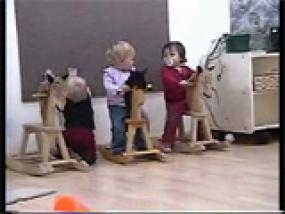Rocking Horse Rumble

Have you ever wondered why young children sometimes seem determined to have the toy their peer or sibling is contently playing with, even when a second toy of the exact same kind is offered, or available nearby? What makes this behavior reasonable to the young child?
In the Thinkprint that follows, we watch several toddlers struggle to have a turn to ride a preferred rocking horse, even when other rocking horses are empty. Ella (in pink) is riding the rocking horse in the middle. Julia (in red) comes over and mounts one of the empty rocking horses. Jacob then crawls over. As he approaches, one rocking horse remains empty. Rather than mounting the empty horse, Jacob uses several strategies to gain access to the rocking horse Ella is riding. Watch as he kneels beside Ella, reaches for her horse with his hand, looks up to make eye contact, and makes a sound to get Ella’s attention. When Ella remains seated, Jacob shifts strategies by directly touching Ella’s leg as if to say, “Move, I want a turn.” Ella responds by touching the handle of the empty rocking horse as if to say, “Jacob, there’s one for you right over here.” We can see that Jacob is frustrated as he puts his palms on the chalkboard and makes several sounds of complaint. Why do you think Jacob is attracted to Ella's rocking horse? What makes one object preferred?
Keywords: Ones, Ride-On Toy, Child-Child, Communication, Possession, Negotiation, Thinkprint
Length of Thinkprint: 12 paragraphs, 8 video subclips
